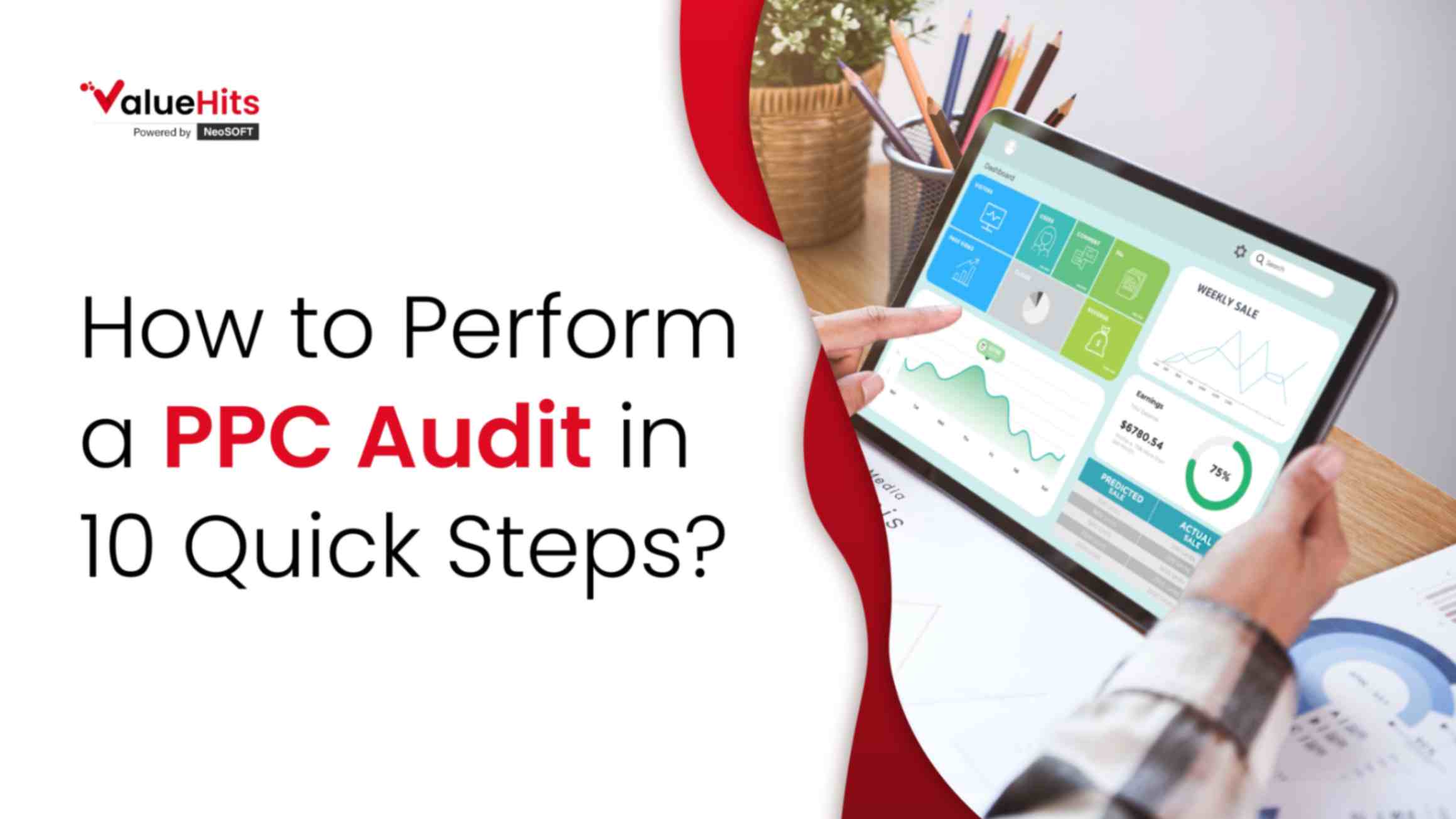KEYWORDS: How to do a PPC Audit in 10 steps 10 Easy steps to perform a PPC Audit The 10 PPC Audit Checklist. How to Audit your ads How to conduct your PPC Audit in 10 easy steps
How to Perform a PPC Audit in 10 Quick Steps?
PPC |
October 20, 2023
Advertising campaigns that don't work well are like throwing money down the drain.

Use our 10-step PPC audit checklist to evaluate and improve your pay-per-click (PPC) strategy.
PPC Audit: What Is It?
A PPC audit in Google Ads is a systematic assessment procedure that aids in assessing the effectiveness of your Google Ads account. A Google AdWords PPC audit is a methodical evaluation process that helps determine how successful your account is. When executed properly, it can pinpoint issues that are contributing to an agency's PPC package underperformance and guide you with valuable data that you can employ to improve the overall performance and well-being of your account. An audit template is required.
The Significance of a PPC Account Audit
A well-crafted campaign has a higher chance of success, which increases the likelihood that money will be made rather than wasted. As a result, a campaign audit is required because a PPC audit provides you with numerous advantages:
- Identify areas of wasted spend.
- Discover new revenue opportunities.
- Enhances management process.
- Gain insights to guide marketing efforts.
- Validate assumptions.
Tip: Using PPC audit software to automate this procedure fully is not a good idea. Although tools can be helpful, a manual review will yield a more insightful audit.
To find areas of success, a good PPC audit examines campaign parameters, expenses, ad groups, and ad effectiveness, and things that require development.
However, a top-notch PPC audit goes one step further by examining what other businesses are doing and modifying your strategy in light of your intended audience.
The 10-Step PPC Audit Checklist
Organization the data
Download and arrange your paid campaign data into spreadsheets to begin your audit.
- Get your Google Ads data in the form of an Excel or Google Sheets spreadsheet.
- Give the spreadsheet a name corresponding to the current year and season (PPC Audit Summer 2023).
- Examine every campaign one by one. Draw attention to trouble spots (like low impressions) and areas of success (such as high conversions).
- When examining successful campaigns, look for patterns among those who aren't.
- These sheets will support you in assessing your progress, visualizing your campaigns at a high level, and providing guidance for any improvements you make to your PPC efforts.
Verify Your Settings
Check the settings by logging into your Google Analytics and Ads accounts. to ensure you're doing everything correctly.
Examine your settings and consider the following queries:
- Are you tracking your conversions correctly? In your Google Ads account, you may view your tracking status.
- Are the naming guidelines you use clear, precise, and descriptive?
Are ad groups categorized and subcategorized appropriately?
Is there a connection between your Google Ads and Analytics accounts? Examine this under "Tools and settings" on your Google Ads account. "Accounts linked" > "Setup" > "Firebase and Google Analytics (GA4)" > "Manage & link." Locate your Analytics property and confirm that "Linked" is the status shown.
Examine the Ad Content
It's time to review the substance of your advertisements now. How a commercial communicates its unique selling proposition (USP) determines whether it succeeds or fails. Your USP was most likely identified when you first organized your PPC campaign. But since then, you've evolved. And so have your competitors and your viewership. It's time to re-evaluate your USP and maximize how your ad content promotes it.
Evaluate Your USP Against Competitors:
- Identify PPC Competitors: Use the Advertising Research tool to find your competitors. Enter your domain and click "Search."
- Check Competitors List: Go to the "Competitors" tab to view a list of your top competitors based on competition level.
- Explore Competitor Metrics: See who's bidding on the exact keywords as you, their paid keyword count, paid traffic, and estimated Google Ads budget.
- Analyze Competitor Websites: Open your top competitors' websites in separate tabs for messaging insights.
Check the Accuracy of Your Ad Copy
Although it may seem simple, checking the accuracy of your advertisement material is a step that should be noticed.
During your PPC audit, search for problems in the ad content, such as:
- Errors in spelling and grammar
- display URLs that are misspelled or inconsistent with the landing page
- outdated advertising
- Past-due prices
Find Optimization Opportunities
Improving ad content will take time, but you can uncover ideas for strengthening your headlines, URLs, and descriptions in your audit.
Optimized ad content will include the following:
- Content that aligns with keyword intent (the rationale behind a searcher's query)
- A call to action
- Relevant keywords
- A USP that sets you apart from the competition
- A clear and captivating title; a display URL that displays the landing page's content
Make Sure Ad Assets Are Being Used
Ad assets are extra links that display even more information. They were formerly referred to as ad extensions. Additionally, they offer simple strategies to boost ad interaction.
Google will automatically decide which assets to show to boost an advertisement's effectiveness. However, not every asset is created automatically.
Ensure that all pertinent ad assets are set up. For Google to select the ideal choices for every advertisement.
Lastly, confirm the accuracy of each of your assets once more.
Verify Your Rating for Quality
More quality in your ad relative to other advertisers' ads is measured by Google Ads Quality Score, which translates into better ad placement and cheaper advertising.
The following criteria determine the Quality Score for each keyword:
- The click-through rate (CTR) anticipated
- Ad significance
- Relevance of landing pages
Go to your Google Ads account and select the "Campaigns" icon to view your Quality Score.
Next, select the "Search Keywords" area.
Click "Keyword Search."
Next, select the icon for columns (three bars) in the table's upper right corner.
Select "Quality Score" from the list of columns to modify for keywords.
You can do better if your Quality Score is a seven or lower. To raise your rating for quality.
Keyword Analysis
It ensures efficient budget use by analyzing keyword targeting.
Ad Group Optimization:
Review ad groups using your PPC audit spreadsheet to improve weak spots. Follow these steps:
- Create tightly themed ad groups.
- Keep ad groups to 20 or less (5-10 keywords per group).
- Remove keywords with low search volumes (<100 monthly searches).
- Adjust ad groups with low impressions.
- Pause seasonal keywords if they're not relevant.
- Align keyword match types with your PPC goals and budget.
Discover New Ad Groups:
To expand your reach, use the Keyword Manager to find new ad group ideas:
- Create a list with seed keywords.
- Enter your domain for better keyword clustering.
- Check the "Mind Map" and "Clusters" reports for insights.
Refine Negative Keywords:
Use negative keywords to save budget and improve relevancy. Check the Google Ads search terms report to identify underperforming search terms, then add them to your negative keywords list.
Competitor Keyword Analysis:
Gain a competitive edge through competitor keyword research in your PPC audit:
- Assess your competitors' past and current ad positions using Advertising Research.
- Examine ads history to identify keywords they target.
- Use the "Position Changes" tab to track their keyword position changes.
- Find keyword gaps using the Keyword Gap tool by comparing your competitors' paid keywords with your own.
CTR and Conversion Rate Assessment:
Evaluate click-through rate (CTR) and conversion rates to enhance ad performance.
- Low CTR can harm Quality Score, while a high CTR with low conversion rates is wasteful.
- Check CTR in your Google Ads dashboard.
- To improve CTR:
- Schedule ads during prime conversion times.
- Adjust CPC bid strategy.
- Test different ad copy.
- Refine audience targeting.
- Ensure cohesive ad groups and keyword relevance.
- Optimize ad assets with up-to-date information.
Location Targeting:
Review and optimize location targeting to reduce wasted spending. Focus on:
- Identifying the best-performing locations in Google Ads.
Bid Review and Adjustment of your bids
Understand how to maximize ROI by evaluating your bidding strategy and performance. Consider switching from automated to manual bidding for better results. Adjust bids based on various factors, including device, location, schedule, demographics, and targeting methods.
Eliminate Wasted Spend
A PPC audit aims to save money by maximizing returns and reducing waste. Implement best practices like optimizing ad schedules, mobile ads, language targeting, and IP exclusions. Additional cost-saving actions include targeting a smaller geographic area, lowering bids on high-click ads, adjusting keyword match types, optimizing negative keywords, and setting ad rotation to "Optimize."
Perform Regular PPC Audits and Ad Optimization
Conducting sponsored search audits at least once every six months is a brilliant idea, or each time you manage a new account.
And remember that there's always room for improvement in ad optimization, mainly when using instruments like advertising research.
Final Word
In conclusion, a well-executed PPC audit can differentiate between throwing money down the drain and running a successful advertising campaign. By following the 10-step PPC audit checklist, you can identify areas of wasted spend, discover new revenue opportunities, and enhance the overall performance of your PPC campaigns.
Regular PPC audits and ad optimization are essential to stay competitive and maximize ROI. Remember, there's always room for improvement, and reviewing and refining your PPC strategy can lead to significant cost savings of your PPC packages and increased success.
How to Use Broad Match Keywords and Ad Scheduling for Your Next Ad?
November 18, 2025
6 Top SEMrush Alternatives for Every Agency Budget
November 11, 2025
